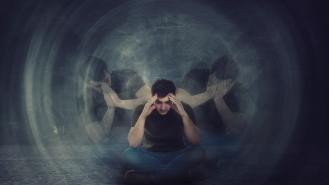In a new series of guest articles, Consultant Forensic Psychiatrist Dr Sohom Das shares stories and insights from his experience working at the crossroads of mental illness and offending. In the second instalment, he addresses the perennial question of what makes a criminal.
I’m a consultant forensic psychiatrist and I live and work in London. I assess and rehabilitate mentally disordered offenders or what the tabloids might call the ‘criminally insane’. I regularly assess defendants in courts, in prisons and in special secure psychiatric units that are reserved for the most dangerous and violent patients.
In my line of work, basic and unavoidable questions are - what makes a criminal? Why are some people more likely to offend than others?
Let’s go for the obvious factors first. Some demographic features are more typical for the average criminal. Violent offences are overwhelmingly committed by males (about 80%), usually in their mid-to-late teens or twenties. When women do tangle with the law, it is more likely to be fraud or prostitution, rather than violence. The male proclivity towards hurting others is a combination of increased testosterone and pressure to uphold their macho image. Distinct gender roles within a judgmental society is also to blame; ‘real’ men are tasked with protecting their family’s honour. It’s the husband who is sent to go downstairs to deal with the murderous intruder in the middle of the night (which turned out to be the cat, once again). Lawbreakers often are raised in dysfunctional families. They are more likely to have abusive parents or caregivers or to be neglected which results in very lax boundaries and developing a broken moral compass. Some even have overly strict parents, who might discipline with violence.
In terms of other environmental factors, many future offenders have friends or family who have spent time at her majesties pleasure. Many grow up in the milieu of poverty and gang culture. Thus, a criminal life provides status in their community. Some kids that grow up in a criminal ecosystem may even be indoctrinated into the life. I have assessed countless violent drug dealers who used to run errands for older relatives as children. They often didn’t do well at school due to problems with authority, which massively impacts their ability to earn a legitimate wage. Many youngsters model immoral behaviour as well. It is well known that a young boy who witnesses domestic violence is more likely to commit this towards future partners. Not only do they see their fists as an appropriate way to manage conflict, but they also enter romantic relationships believing that there needs to be a clear power dynamic.
So far, so obvious.
Let’s delve a bit deeper into the psychology of offenders. They are more likely to have certain personality traits; impulsiveness or thrill-seeking. They are more likely to take up illegal opportunities and not consider the consequences of their actions. Another common criminogenic outlook is having an ‘external locus of control’. This boils down to refusing to accept responsibility. An internal justification for their misdeeds. It is something that I see very regularly when I’m assessing defendants to give evidence in their criminal trials. Statements that I have heard from my career which illustrate this curious psychological anomaly include:
‘If the government hadn’t stopped my benefits, I wouldn’t need to go out and burgle houses.’
‘My mate shouldn’t have asked me to carry that knife for him in the first place.’
‘It was the alcohol, doctor. It makes me nippy. It was inevitable really.’
Other specific psychological processes that felons utilise to conceptualise their own crimes and therefore continue to commit them include justification and rationalisation.
These are similar, though with subtle differences. An example of justification is somebody saying that they had to pre-emptively act violently because if they didn’t, they would have been hurt.
Rationalisation is more general, such as the ethos that people who get conned deserve it. Offenders like to indulge in minimalisation; i.e. downplaying the impact of their crime to others and even to themselves. That bouncer must be used to squaring up to punters, so it’s probably not that big a deal for him to have his jaw smashed.
There is an, admittedly weak, correlation with intelligence too. Despite the archetype of criminal masterminds, the genius James Bond villain stroking a cat in their secret layer, violent criminals (though not others, like fraudsters) have lower IQs than the general population. This can decrease their chances of finding legal employment and therefore indirectly push them towards crime. It also increases their chances of being caught.
As a forensic psychiatrist I of course cannot ignore the overlap between mental illness and criminality. Although very rare, sometimes there is direct causation between symptoms and violence. I have assessed numerous sufferers of schizophrenia who hear voices, known as command hallucinations, compelling them to attack other people. Others suffer from paranoid delusions and are convinced that strangers are following them, watching them, wish to harm them or even kill them. Understandably, a proportion of these poor souls will lash out in the incorrect belief that they are in danger.
However, far more common within my cohort of clients are personality disorders; deeply ingrained, pervasive faults in the subject’s natural temperament and nature. Antisocial personality disorder (also known as dis-social personality disorder) is almost ubiquitous within the offender profile group and within the individuals I assess in prisons, in court and in secure psych units. This is a mental condition in which one consistently shows no regard for right and wrong, lack empathy and ignore the rights and feelings of others. People with this diagnosis tend to be impulsive and aggressive and often become career criminals.
Another huge factor is substance abuse. This is intrinsically connected to crime via many different mechanisms. Addicts need a constant supply of money to feed their drug habits. Users become more impulsive, violent or disinhibited when intoxicated by drugs or alcohol. They come into contact with felons for the supply of substances, which might increase their chance of being drawn into the lifestyle.
Analysing criminogenic factors is not about excusing actions. It’s about understanding them. It’s easy to vilify criminals, and often appropriate. But an uncomfortable truth remains. A huge proportion of violent offenders were once victims themselves. Most have experienced a combination of the many vicissitudes of life. From physical and sexual abuse, to neglect, to poverty, to mental illness to substance abuse. They must accept responsibility for their actions as adults and the damage they cause their victims cannot be overlooked. Nevertheless, from my experience, their problems started when they were vulnerable, naïve, highly suggestible children. Can you be sure that you wouldn’t be tempted into a life of crime if you were shown very few other options in childhood? I know I couldn’t…
About the author: Dr Sohom Das is the host of a YouTube video podcast called A Psych for Sore Minds that discusses his own real-life cases (anonymising his patients), to give viewers an insight into his work. The podcast covers a whole range of topics related to true crime and mental illness in which Dr Das uses his professional perspective as a Consultant Forensic Psychiatrist to dissect the crossover between the two.
If you are interested in the social theories behind violent offending, check out Sohom's video on the subject.








